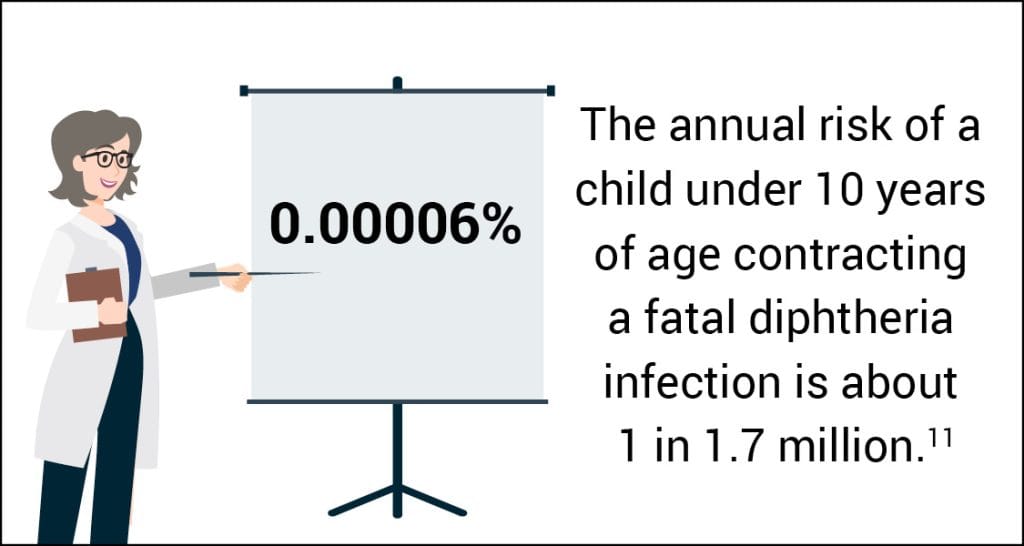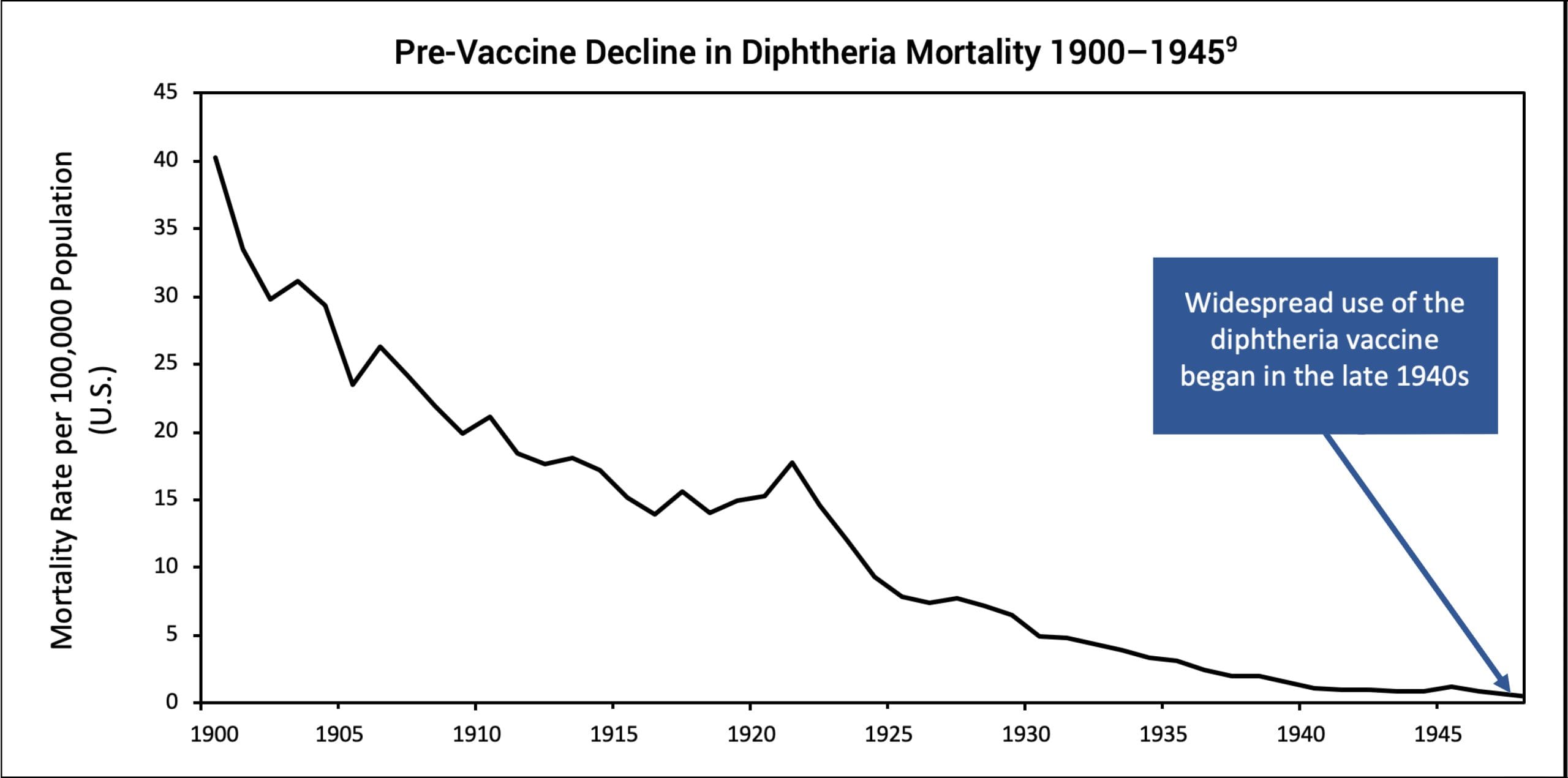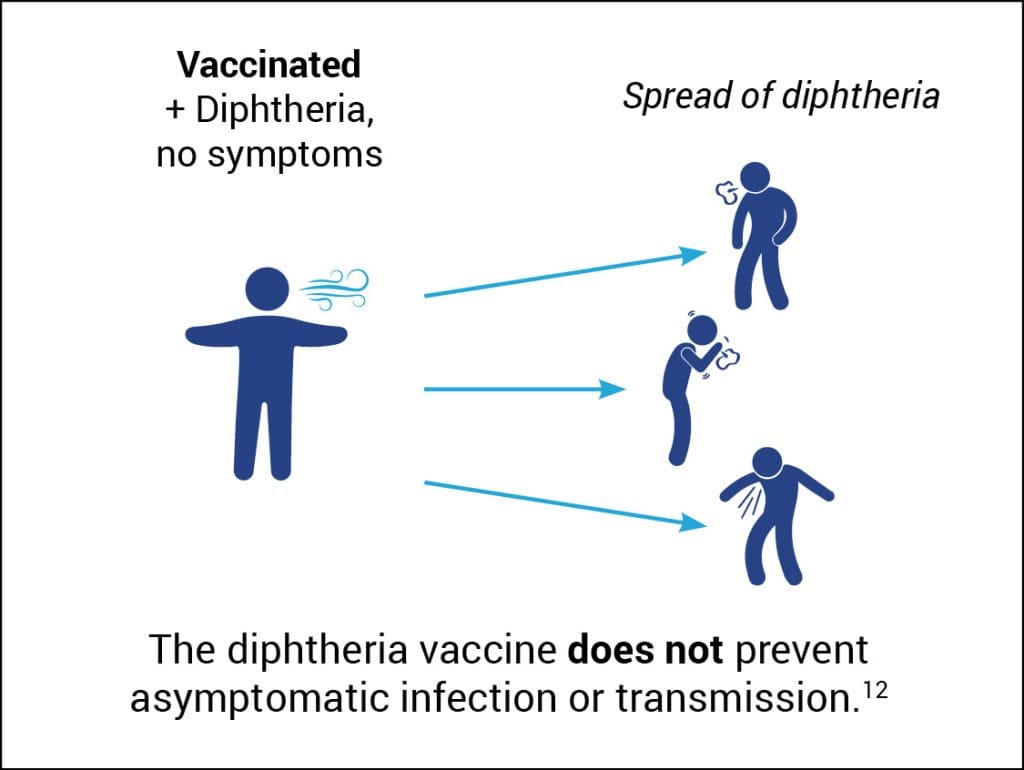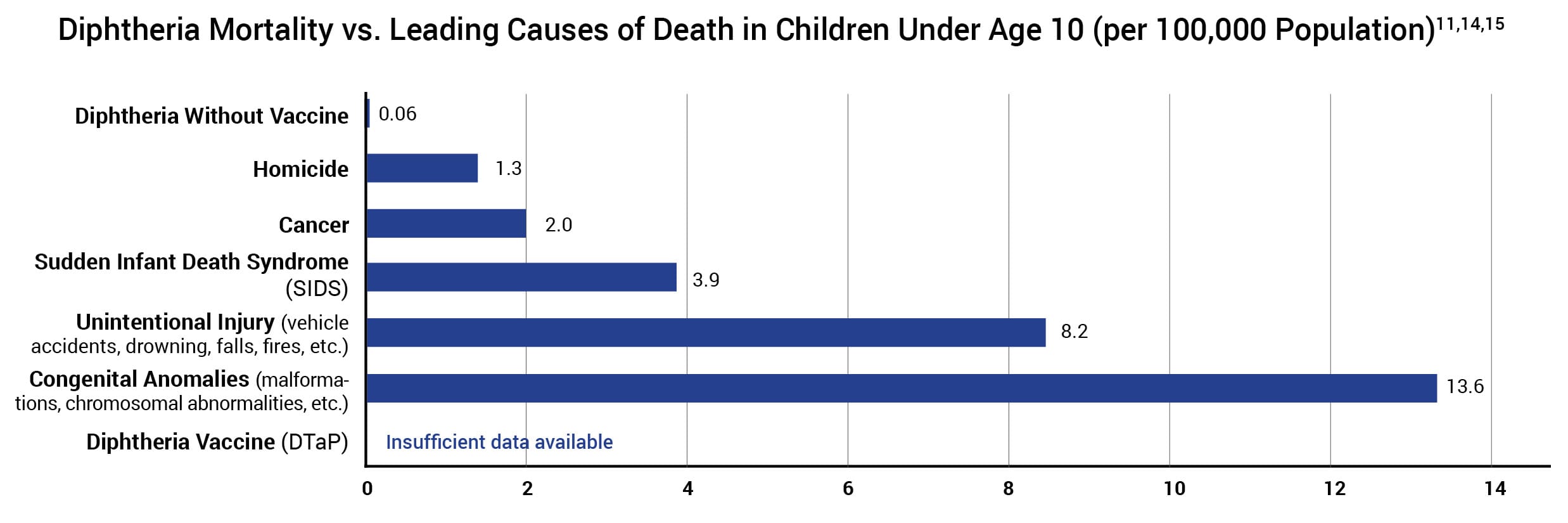Diphtheria: What You Need to Know
 1. WHAT IS DIPHTHERIA?
1. WHAT IS DIPHTHERIA?
Diphtheria is a bacterial infection.
- Diphtheria is usually asymptomatic (has no symptoms).1
- In noticeable cases, diphtheria can cause sore throat, loss of appetite, and low-grade fever. Some cases develop a barking cough, swelling of the neck, and airway obstruction. In most cases, symptoms resolve after several days.2
- Before widespread use of the diphtheria vaccine in the late 1940s, about 83% of diphtheria deaths occurred in children of age 9 or younger,3 and about 9% of symptomatic cases were fatal.4 However, due to advancements in living conditions, sanitation, and nutrition,5 the diphtheria case fatality rate declined to 4% in the 1970s,6 and the incidence of diphtheria declined from 190 per 100,000 in 19217 to 13 per 100,000 in 19458 — about a 93% decline.
 2. WHAT ARE THE RISKS?
2. WHAT ARE THE RISKS?
Although diphtheria infection was widespread in the late 19th century, by the early 1940s, diphtheria had become a disease of low incidence — the annual risk of contracting diphtheria was about 1 in 7,500.8
In the modern era, it is rare to contract a fatal case of diphtheria in the United States. Between 1900 and 1945, before widespread use of the diphtheria vaccine, the mortality rate of diphtheria dropped from 40.3 per 100,000 to 1.2 per 100,000 in the population, due to advancements in living conditions, sanitation, and nutrition — a 97% decline (Fig. 1).9 High rates of diphtheria are associated with overcrowding and poor sanitation.10
Research studies estimate that, in the absence of mass vaccination, the annual risk of a child younger than 10 years of age contracting a fatal case of diphtheria in the U.S. in the 21st century is about 1 in 1.7 million or 0.00006%.11


Figure 1: The diphtheria death rate declined by 97% from 1900 to 1945, before widespread use of the diphtheria vaccine in the late 1940s.
3. WHAT TREATMENTS ARE AVAILABLE?
Diphtheria can be treated with diphtheria antitoxin and antibiotics (erythromycin or procaine penicillin G). Respiratory support and airway maintenance can also be used if needed.1

4. WHAT ABOUT THE DIPHTHERIA VACCINE?
Widespread use of diphtheria toxoid (vaccine) in the U.S. began in the late 1940s, and diphtheria toxoid was combined with tetanus toxoid and pertussis vaccine as DTP in 1948. It has significantly reduced the incidence of diphtheria infections; however, the vaccine does not prevent asymptomatic infection or transmission.12

The manufacturer’s package insert contains information about vaccine ingredients, adverse reactions, and vaccine evaluations. For example, the diphtheria vaccine “has not been evaluated for carcinogenic or mutagenic potential or impairment of fertility.”13 Furthermore, the risk of permanent injury or death from the diphtheria vaccine has not been proven to be less than that of diphtheria (Fig. 2).14

Figure 2: This graph shows the diphtheria death rate in the absence of mass vaccination and compares it to the leading causes of death in children under age 10 today. Hence, in the absence of mass vaccination, the diphtheria death rate per 100,000 is 0.06 for children under age 10. In 2015, the death rate per 100,000 for homicide was 1.3, followed by cancer (2.0), SIDS (3.9), unintentional injury (8.2), and congenital anomalies (13.6). The rate of death or permanent injury from the diphtheria vaccine is unknown because the research studies available are not able to measure it with sufficient accuracy.
REFERENCES
- Centers for Disease Control and Prevention. Epidemiology and prevention of vaccine-preventable diseases. 13th ed. Hamborsky J, Kroger A, Wolfe S, editors. Washington, D.C.: Public Health Foundation; 2015. 111. https://physiciansforinformedconsent.org/cdc-pink-book-13th-edition-2015/.
- Centers for Disease Control and Prevention. Epidemiology and prevention of vaccine-preventable diseases. 14th ed. Hall E, Wodi AP, Hamborsky J, Morelli V, Schillie S, editors. Washington, D.C.: Public Health Foundation; 2021. 98. https://physiciansforinformedconsent.org/cdc-pink-book-14th-edition-2021/.
- United States Public Health Service. Vital Statistics of the United States 1945 Part 1. Table 5 — Deaths from each cause, by age, race, and sex: United States, 1945. Washington, D.C.: U.S. Government Printing Office; 1947. 54. https://www.cdc.gov/nchs/data/vsus/vsus_1945_1.pdf; 1,321 of the 1,598 fatal cases of diphtheria (83%) were under age 10.
- Centers for Disease Control and Prevention. Annual summary 1980: Reported morbidity & mortality in the United States. MMWR Morb Mortal Wkly Rep. 1981 Sep;29(54):16. https://stacks.cdc.gov/view/cdc/1484; in 1945, there were 18,675 cases of diphtheria of which 1,598 were fatal,3 resulting in a case fatality rate of about 9%.
- Schuman LM, Doull JA. Diphtheria infection and morbidity in Cleveland, 1937–1939. Am J Pub Health. 1940 Mar;30(3Suppl):16-24. https://www.ncbi.nlm.nih.gov/pmc/articles/PMC1530699/.
- Centers for Disease Control and Prevention. Epidemiology and prevention of vaccine-preventable diseases. 13th ed. Hamborsky J, Kroger A, Wolfe S, editors. Washington, D.C.: Public Health Foundation; 2015. Appendix E-1. https://physiciansforinformedconsent.org/cdc-pink-book-13th-edition-and-appendix-e-2015-combo; between 1971 and 1975, there were about 1,174 cases of diphtheria of which 43 were fatal, resulting in a case fatality rate of about 4%.
- Centers for Disease Control and Prevention. Epidemiology and prevention of vaccine-preventable diseases. 13th ed. Hamborsky J, Kroger A, Wolfe S, editors. Washington, D.C.: Public Health Foundation; 2015. 112. https://physiciansforinformedconsent.org/cdc-pink-book-13th-edition-2015/; in 1921, there were 206,000 cases of diphtheria out of population of 109 million (190 cases per 100,000 population).
- Centers for Disease Control and Prevention. Annual summary 1980: Reported morbidity & mortality in the United States. MMWR Morb Mortal Wkly Rep. 1981 Sep; 29(54);16. https://stacks.cdc.gov/view/cdc/1484; in 1945, there were 18,675 cases of diphtheria out of population of 140 million — 1 in 7,500 or 13 cases per 100,000 population.
- Grove RD; Hetzel AM; U.S. Department of Health, Education, and Welfare. Vital statistics rates in the United States 1940–1960. Washington, D.C.: U.S. Government Printing Office;1968. 559-96. https://stacks.cdc.gov/view/cdc/6200.
- Vitek CR, Wharton M. Diphtheria in the former Soviet Union: reemergence of a pandemic disease. Emerg Infect Dis. 1998 Oct-Dec;4(4): 540, 546, 547. https://www.ncbi.nlm.nih.gov/pmc/articles/PMC2640235/.
- Magno H, Golomb B. Measuring the benefits of mass vaccination programs in the United States. Vaccines. 2020 Sep 29;8(4):4. https://pubmed.ncbi.nlm.nih.gov/33003480/; 83%3 (23) of the 28 diphtheria deaths reported in the study were less than 10 years of age. Because there are about 40 million such children in the population, the risk of fatal diphtheria for those children is 23 in 40 million (1 in 1.7 million).
- Miller LW, Older JJ, Drake J, Zimmerman S. Diphtheria immunization. Effect upon carriers and the control of outbreaks. Am J Dis Child. 1972 Mar;123(3):197-9. https://pubmed.ncbi.nlm.nih.gov/5026197.
- Sanofi Pasteur Limited. Toronto, Ontario, Canada: Sanofi. Daptacel (diphtheria and tetanus toxoids and acellular pertussis vaccine adsorbed); [cited 2023 Sep 4]. https://www.fda.gov/media/74035/download.
- Physicians for Informed Consent. Newport Beach (CA): Physicians for Informed Consent. DTaP — vaccine risk statement (VRS). DTaP vaccine: is it safer than diphtheria, tetanus, and pertussis? 2023 Nov. 2023 Nov. https://physiciansforinformedconsent.org/dtap-vaccine-risk-statement/.
- Centers for Disease Control and Prevention. Washington, D.C.: U.S. Department of Health and Human Services. 10 leading causes of death by age group, United States — 2015. https://physiciansforinformedconsent.org/cdc-leading-causes-of-death-age-group-2015/.
Published 2023 Nov; updated 2024 Aug


